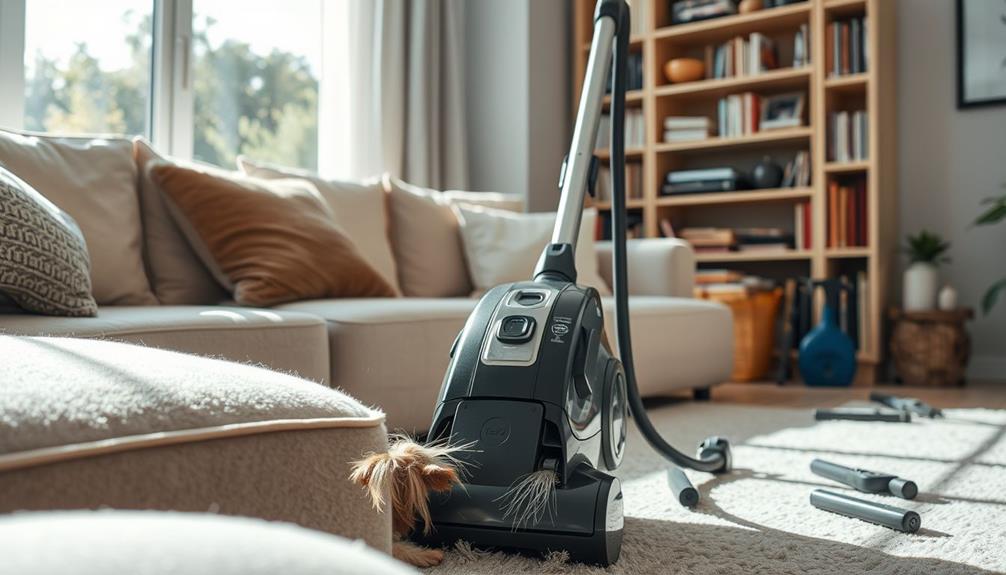Your vacuum cleaner can do more than just clean floors; it’s a useful tool for unexpected chores. Utilize it to remove dust from light fixtures or clean your car’s interior with specialized attachments. You can even place a mesh filter over the hose to catch small lost items like earrings. Combat allergens by regularly vacuuming bedding and upholstery. Remember to clean tight spaces such as window tracks and kitchen drawers for hidden dust. Your vacuum has so much potential, and the following tips will help you unlock it to the fullest extent.
Key Takeaways
- Use a mesh attachment over the vacuum hose to catch small lost items like earrings and screws while cleaning.
- Vacuum car interiors effectively with crevice tools to remove dirt and crumbs from hard-to-reach areas.
- Regularly vacuum upholstery to reduce allergens and maintain cleanliness in fabric areas.
- Clean vertical surfaces like walls and ceilings with a brush attachment for optimal dust removal.
- Target hidden allergens by vacuuming kitchen drawers, bathroom exhaust fans, and window tracks more effectively than traditional dusting methods.
Effective Vacuuming Techniques
When it comes to effective vacuuming techniques, you'll find that starting from the ceiling and working your way down makes a considerable difference. This method prevents dust and debris from falling onto already cleaned surfaces, enhancing your overall vacuum performance.
Utilizing specialized vacuums designed for specific surfaces, such as vacuums for luxury vinyl plank (LVP) floors, can also contribute to a more efficient cleaning process. Use vacuum attachments like the dust brush for shelves and the upholstery tool for furniture to address specific cleaning tasks thoroughly.
Don't forget to adjust your vacuum's carpet pile-height setting based on the level of dirt present. This optimization is vital for maximizing suction power and cleaning efficiency. If you encounter particularly dirty areas, make multiple passes. This extra effort guarantees thorough dirt removal, greatly improving your vacuuming results.
Regular maintenance is essential, too. Clean the filters and empty the bags or bins before they're full to sustain consistent suction power. Neglecting this can lead to decreased vacuum performance, leaving dirt behind.
Choosing the Right Vacuum
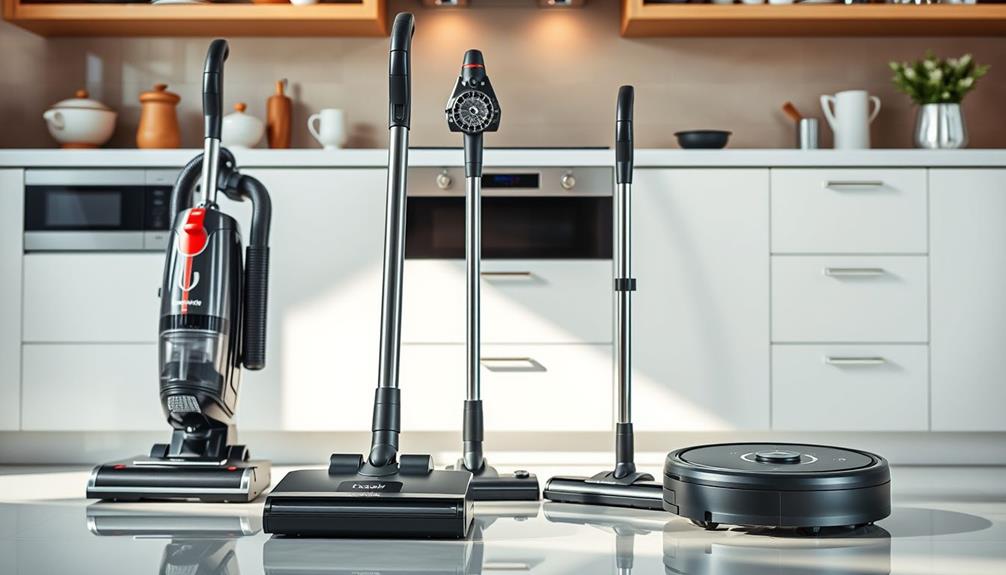
When you're picking a vacuum, think about your home environment and the types of messes you encounter.
For larger spaces with carpets and pets, a full-sized upright or canister vacuum might be your best bet, especially those with features like self-cleaning brush roll technology that reduce maintenance time.
On the other hand, if you're in a smaller place or just need quick cleanups, a stick or handheld vacuum could work perfectly.
Vacuum Types Explained
Choosing the right vacuum cleaner can make all the difference in keeping your home clean and comfortable. When it comes to vacuum performance, you'll want to evaluate the type of vacuum that meets your needs.
Full-sized upright and canister vacuums excel at deep cleaning tasks, especially in homes with carpets and pets. Their powerful suction and larger capacity can tackle stubborn dirt and hair effectively. Additionally, maintaining a clean indoor environment is vital, as poor air quality can exacerbate allergies and respiratory issues; using a vacuum with HEPA filtration can greatly improve your home's air quality by trapping allergens.
If you're looking for convenience, stick and handheld vacuums are perfect for quick cleanups. They're lightweight and easy to maneuver, making them ideal for addressing small messes in busy households. Plus, they're great for daily use.
Robot vacuums have become increasingly popular, offering automated cleaning with minimal effort. With some effective models available for around $150, they provide a helpful solution for maintaining cleanliness without much hassle.
For those with allergies, selecting a vacuum with HEPA filtration is essential. This feature effectively traps allergens and enhances your indoor air quality, ensuring a healthier environment.
Consider Home Environment
Your home environment plays a significant role in selecting the right vacuum cleaner. Understanding your specific needs can drastically improve vacuum performance and streamline your cleaning routine. Here are three key factors to take into account:
1. Carpets and Pets: If you have heavy carpeting or furry friends, opt for a full-sized upright or canister vacuum. These models typically offer superior suction power and larger dirt capacities to tackle deep cleaning tasks effectively.
Additionally, it's important to verify company reputation through reviews and ratings when choosing a cleaning service to guarantee you make an informed decision.
2. Small Spaces: For quick cleanups or smaller living areas, stick or handheld vacuums are your best bet. They provide flexibility and convenience without the bulk of traditional vacuums, making them perfect for everyday messes.
3. Daily Maintenance: Robot vacuums are a great choice for maintaining cleanliness with minimal effort, especially with prices around $150. They work quietly in the background, ensuring your floors stay tidy.
Additionally, if you or your family suffers from allergies, think about models with HEPA filters. These features help capture allergens, contributing to better indoor air quality.
Vacuum Maintenance Tips

Maintaining a vacuum cleaner is vital for keeping it running efficiently and effectively. To guarantee ideal suction power, change vacuum bags when they're three-fourths full. This simple step prevents reduced performance during your cleaning sessions.
After each use, empty dirt bins to maintain consistent performance and avoid clogs that can hinder suction efficiency. Just as cats exhibit signs of stress when their environment is disrupted, a well-maintained vacuum cleaner can help create a more serene home atmosphere for both you and your pets.
Regularly inspect and clean the brush roll to eliminate tangles and debris; this is essential for your vacuum's ability to pick up dirt effectively. Additionally, replace filters as recommended by the manufacturer. Clogged filters can greatly reduce suction power, impacting your overall cleaning results.
Follow the manufacturer's maintenance guidelines to prolong your vacuum cleaner's life and guarantee it operates at peak performance. These vacuum maintenance tips won't only enhance your cleaning experience but also save you money on repairs and replacements in the long run.
Allergen Management Strategies
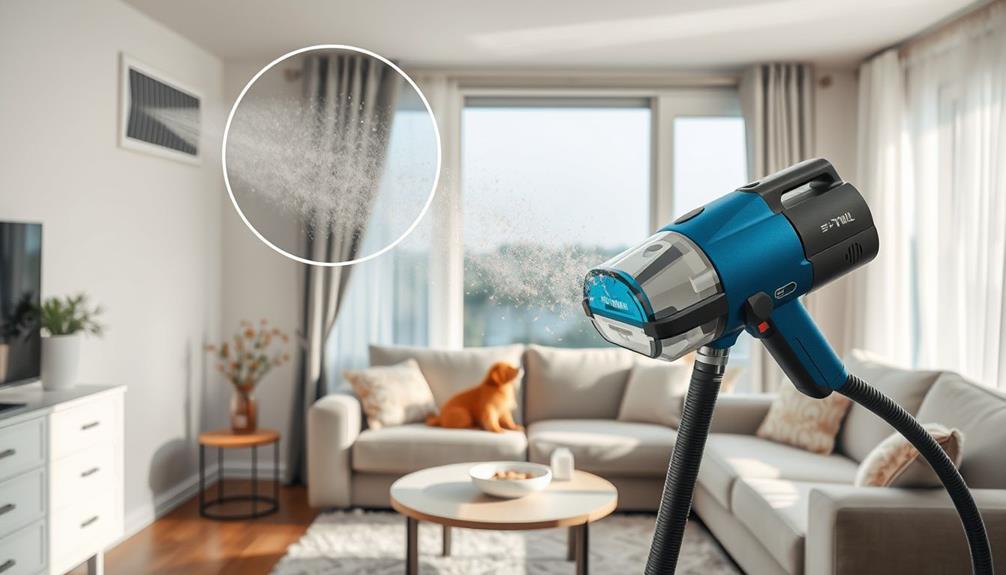
To manage allergens effectively, you should consider using a vacuum with a HEPA filter, which captures nearly all harmful particles.
Incorporating stress management techniques can also enhance your overall well-being, helping you cope with any allergy-related stress.
Regular vacuuming is essential, especially in high-traffic areas and on upholstery, to keep allergen levels down.
HEPA Filter Benefits
When it comes to managing allergens in your home, HEPA filters stand out as an essential tool. These filters can trap 99.97% of particles as small as 0.3 microns, considerably improving your indoor air quality.
By regularly using a vacuum equipped with HEPA filters, you can reduce allergens like pollen, pet dander, and dust mites, making a noticeable difference for allergy sufferers. Additionally, utilizing essential oils for relaxation can further enhance your indoor environment and support overall well-being.
Here are three key benefits of using HEPA filters in your vacuum:
- Pet hair and dander: HEPA filters effectively capture pet hair and dander, which are common allergens in pet-friendly homes.
- Air quality improvement: Frequent vacuuming with HEPA filters leads to a measurable decrease in allergen levels, enhancing overall health and comfort.
- Optimal performance: To maximize HEPA filter effectiveness, remember to replace or clean them according to the manufacturer's recommendations.
Incorporating HEPA filters into your cleaning routine not only addresses allergens but also promotes a healthier living environment.
Regular Vacuuming Importance
Regular vacuuming plays an essential role in managing allergens and keeping your home healthy. By vacuuming regularly, you can eliminate up to 96% of fleas and their larvae, drastically reducing allergen levels in your living space.
Additionally, consider investing in a vacuum that features smart technology integration for enhanced cleaning efficiency, similar to the benefits offered by modern garage door openers. To enhance your vacuum performance, choose a vacuum equipped with HEPA filters. These filters effectively trap allergens like dust mites, pet dander, and pollen, helping to improve your indoor air quality.
Make it a habit to vacuum high-traffic areas and mess-prone zones systematically. This strategy helps maintain cleanliness and minimizes allergen buildup.
Don't forget to clean your bedding and upholstery regularly, as dust and dead skin cells are common allergens that can affect your health.
Scheduling your vacuuming sessions during low pollen times is another smart move, especially if you're an allergy sufferer. This not only keeps your home clean but also prevents outdoor allergens from infiltrating your indoor environment.
Maximizing Cleaning Efficiency
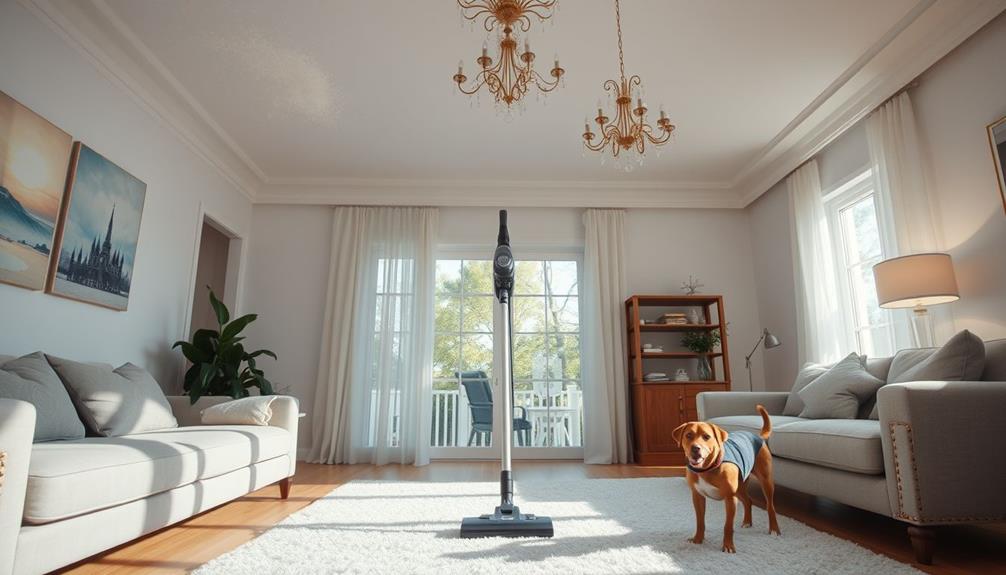
Maximizing cleaning efficiency is all about strategy and planning. By focusing on high-traffic and mess-prone areas first, you'll enhance your vacuum performance and tackle the dirtiest spots effectively. Incorporating a healthy lifestyle can also improve your overall well-being, making you more energetic and efficient during cleaning tasks.
Here are three key strategies to contemplate:
- Systematic Vacuuming: Vacuum in straight lines and overlap your passes. This guarantees no area is missed and boosts your vacuum performance with every sweep.
- Organized Attachments: Keep your vacuum attachments neatly arranged and within easy reach. This minimizes downtime when switching tasks, allowing you to maintain momentum throughout your cleaning session.
- Regular Scheduling: Set a vacuuming schedule, ideally once a week. This practice helps maintain cleanliness, reduces dirt buildup, and improves overall indoor air quality.
Experiment with different vacuuming patterns, like the "S" or circular method, to find what works best for your space.
Vacuuming for Home Cleaning

Vacuuming plays a pivotal role in maintaining a clean and healthy home environment. By using vacuum cleaners regularly, you can effectively reduce dust, allergens, and bacteria that accumulate in various areas of your home.
Additionally, employing proper cleaning practices guarantees that your vacuum cleaner remains in prime condition and performs efficiently. Start with your beds; vacuum upholstered headboards and mattresses monthly to eliminate dust mites and guarantee peak hygiene.
Don't forget vertical surfaces! A vacuum with a brush attachment can easily clean walls and ceilings, helping you remove dust and spider webs. This top-down approach makes your cleaning process more efficient.
Monthly vacuuming of upholstery, including your sofas and curtains, prevents stains and keeps them looking fresh by removing crumbs and loose particles.
For those tight spaces—like window tracks and kitchen drawers—vacuuming is quicker and more effective than using cloths, minimizing dust buildup.
Dust and Allergen Removal
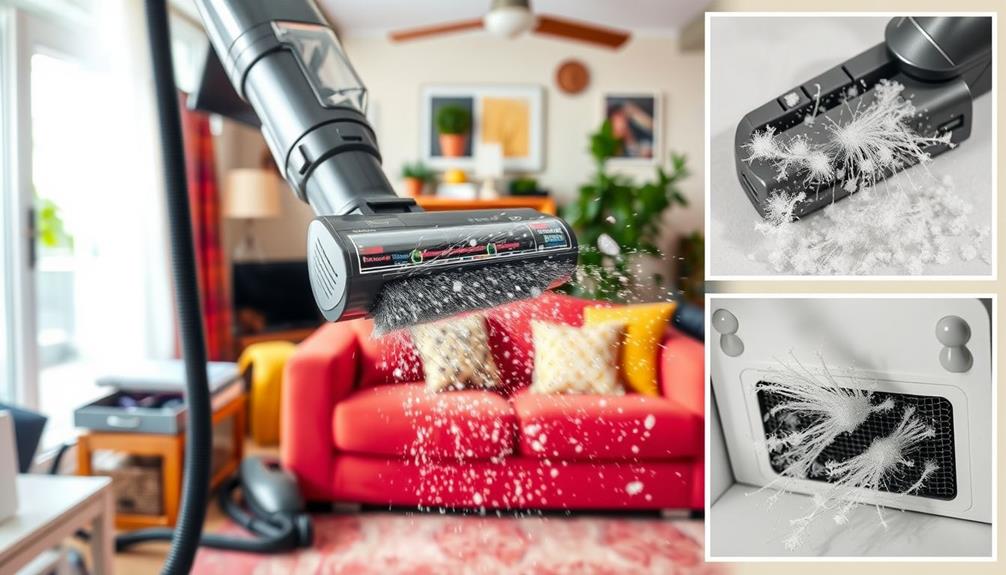
Often overlooked, effective dust and allergen removal is vital for maintaining a healthy home.
Regular vacuuming can greatly reduce allergens like dust mites, human skin cells, and even fleas, making it an important part of your cleaning routine.
Regular play and physical activity for children can also help reduce allergens as they engage in outdoor play, which promotes a healthier environment outdoor play benefits.
Here are three key areas where your vacuum can shine:
- Window Tracks: Use specialized attachments to reach those tight spaces, eliminating dust and debris that accumulate over time.
- Kitchen Drawers: Skip the traditional dusting and vacuum these areas instead. It's faster and guarantees you're removing hidden allergens that can affect your health.
- Bathroom Exhaust Fans: Keep air quality high by vacuuming these fans. This not only removes dust but also prevents the buildup of debris that can hinder their function.
Light Fixture Maintenance

To keep your home bright and inviting, regular maintenance of light fixtures is vital. Dust and grime can accumulate quickly, diminishing brightness by up to 50%. To prevent this, make vacuuming your light fixtures a part of your cleaning routine.
Start with fabric shades—use the gentle brush attachment on your vacuum. This'll effectively remove dust without damaging the material. For beaded shades, vacuum frequently to avoid dust buildup, which can lead to permanent stains or discoloration.
When it comes to glass shades, begin by using the vacuum to eliminate loose dust. After that, tackle tougher grime with a soft damp cloth or a gentle glass cleaner for a sparkling finish. This two-step process guarantees your fixtures shine brightly and maintain clarity, enhancing the overall illumination in your space.
Regularly vacuuming your light fixtures not only improves light output but also keeps your home looking its best. So, grab that brush attachment and give your fixtures the care they deserve!
Specialized Vacuuming Applications
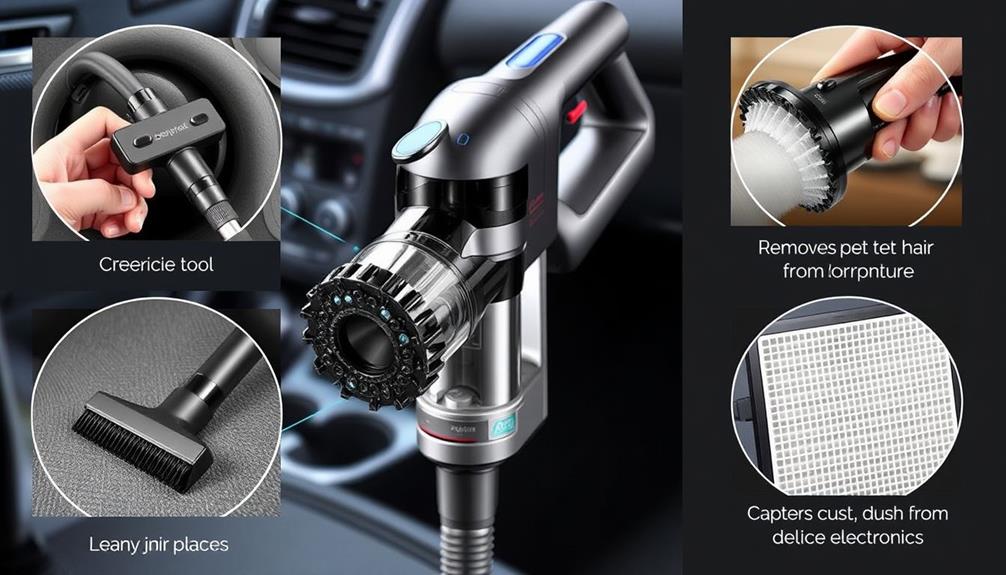
Specialized vacuuming applications can transform your cleaning routine, making it more efficient and effective. One way specialized vacuuming applications can enhance your cleaning routine is through the use of vacuum cleaner attachments. These attachments allow you to reach and clean difficult-to-reach spaces, such as crevices, upholstery, and even ceilings. By having the right attachments for the job, you can ensure that every surface in your home is thoroughly cleaned, resulting in a healthier and more pleasant living environment.
With a few clever techniques, you can tackle those tough spots and retrieve lost items with ease. Here are three specialized uses for your vacuum cleaner:
- Lost Item Retrieval: Attach a mesh over the vacuum hose's crevice tool to catch small items like earrings, screws, and nails while you vacuum hard-to-reach areas. You'll be amazed at what you find!
- Car Interior Cleaning: Use your vacuum cleaner to give your car a thorough clean. The crevice tool works wonders in tight spaces, while a car suction nozzle helps you manage larger areas, picking up dirt and crumbs effortlessly.
- Upholstery Maintenance: Regular vacuuming of your sofas and curtains not only keeps them clean but also reduces allergens. Use the vacuum hose to get into fabric nooks where dust tends to hide.
Incorporating these specialized applications into your cleaning routine will help you make the most of your vacuum and keep your home and car in top shape.
Frequently Asked Questions
What Are the 10 Uses of a Vacuum Cleaner?
A vacuum cleaner's versatility goes beyond just cleaning floors. You can recover lost items by using a mesh over the crevice tool.
Regularly vacuuming upholstery helps prevent stains and allergens. If you've got a HEPA filter, it traps dust and pet dander, improving air quality.
Vacuuming light fixtures brightens your space, and you can even compress bulky items for storage. It's a handy tool that makes maintaining your home easier.
What Can I Put in My Vacuum to Make It Smell Good?
If you want your vacuum to smell good while you clean, try adding a few drops of essential oils to a cotton ball and placing it in the bag or dirt bin.
You can also sprinkle some baking soda inside the vacuum bag to neutralize odors.
Alternatively, use scented vacuum discs or even dryer sheets, which will release a fresh scent as you vacuum.
Mixing baking soda with essential oils for a DIY powder is another great option!
How Can I Make My Vacuum More Effective?
To make your vacuum more effective, start by adjusting the pile-height setting to match your carpet type and dirt level.
Regularly empty the dirt bin or change bags when they're three-fourths full to maintain suction.
Use attachments for targeted cleaning in hard-to-reach spots, and don't forget to clean the brush roll to prevent clogs.
Establish a vacuuming schedule, focusing on high-traffic areas to keep your space fresh and reduce deep cleaning needs.
Does Baking Soda Help Vacuum?
Yes, baking soda can definitely help your vacuuming routine.
When you sprinkle baking soda on your carpets, it absorbs odors, making your home smell fresher. Just let it sit for about 15 minutes before you vacuum, so it can work its magic.
Using a vacuum with a HEPA filter is best, as it keeps the particles from escaping back into the air.
Regularly using baking soda can really enhance your indoor air quality.
Conclusion
To sum up, your vacuum cleaner is more than just a floor companion; it's a versatile ally in your cleaning arsenal. By embracing its unexpected capabilities, you can elevate your home's cleanliness to new heights. Remember, a little regular maintenance goes a long way, ensuring your trusty machine remains in tip-top shape. So, next time you reach for it, think beyond the ordinary and let your vacuum work its magic in ways you hadn't imagined.
